London (Peirsonhamna)
[78° 57' N 12° 00' E]
By Øystein Overrein (ed.), Jørn Henriksen, Bjørn Fossli Johansen, Kristin Prestvold
On the south side of the fjord of Kongsfjorden lies the unique cultural heritage site of London, also called Ny-London. This is the remains of the mining facility established in 1911 by the Northern Exploration Company, an English company headed by Ernest Mansfield. At London, marble was extracted for a limited time at the start of the 20th century.
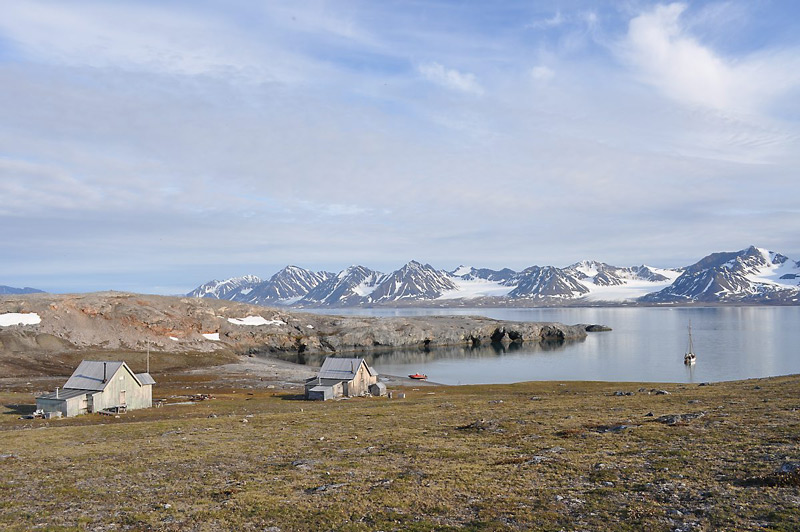 Overview of London with the remains of the mining facility established in 1911 by the Northern Exploration Company. (Image: Geir Wing Gabrielsen / The Norwegian Polar Institute) Take care:
- Cultural remains must not be disfigured or destroyed.
- Cultural remains are vulnerable to being trodden upon. Avoid walking and standing in the cultural remains (does not apply to the cabins).
- Do not remove any cultural remains from the site.
 Marble deposits in London. (Image: Lise Øvrum / The Governor of Svalbard) Marble deposits in London. (Image: Lise Øvrum / The Governor of Svalbard)
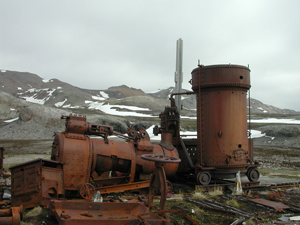 The locomotive in the remains of the workshop hall above the houses of London. It recalls the over-optimistic belief and investment in the quarrying of marble to supply European manors. (Image: Kristin Prestvold / The Governor of Svalbard) The locomotive in the remains of the workshop hall above the houses of London. It recalls the over-optimistic belief and investment in the quarrying of marble to supply European manors. (Image: Kristin Prestvold / The Governor of Svalbard)
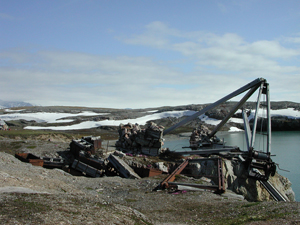 Derrick crane and railway wagons, etc. at the shipping quay on the west side of the harbour of Peirsonhamna. Camp Mansfield lies all the way to the left. (Image: Kristin Prestvold / The Governor of Svalbard) Derrick crane and railway wagons, etc. at the shipping quay on the west side of the harbour of Peirsonhamna. Camp Mansfield lies all the way to the left. (Image: Kristin Prestvold / The Governor of Svalbard)
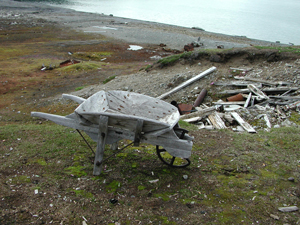 The wheelbarrow at London – a protected single cultural remain. Such individual items should not be removed or moved, but you’re welcome to enjoy the sight and take pictures. The erosion of the ground behind is evident. All traffic to the houses should take place outside the left picture border. (Image: Kristin Prestvold / The Governor of Svalbard) The wheelbarrow at London – a protected single cultural remain. Such individual items should not be removed or moved, but you’re welcome to enjoy the sight and take pictures. The erosion of the ground behind is evident. All traffic to the houses should take place outside the left picture border. (Image: Kristin Prestvold / The Governor of Svalbard)
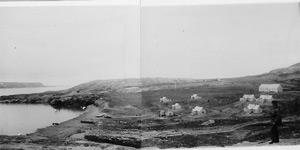 London in 1916. The two houses farthest away are used by the employees in Ny-Ålesund. The other houses have been relocated across the fjord. Verkstedhallen to the right. (Image: Adolf Hoel / The Norwegian Polar Institute) London in 1916. The two houses farthest away are used by the employees in Ny-Ålesund. The other houses have been relocated across the fjord. Verkstedhallen to the right. (Image: Adolf Hoel / The Norwegian Polar Institute)
History
The story of the mining settlement of London and the marble deposits on the island of Blomstrandhalvøya is bound to the English company the Northern Exploration Company and the adventurer Ernest Mansfield. The marble deposits were discovered in the summer of 1906 and described as “no less than an island of pure marble”. The facility is an excellent representative of the Klondike gold rush feeling that prevailed in Svalbard at the time. According to the contemporary geologist Adolf Hoel, next to coal mining, this was the largest economic enterprise started in Svalbard.
The marble quarry was established in 1911. In a few years, intense labour was invested to get the plant and operation up and running. The marble seemed promising, and experts from around the world praised the quality and beauty of the stone. Expectations were big and high economic yields were anticipated. Machines, railway, wagons, cranes, winches, heavy steam engines, tools and equipment for operations were brought in. Private houses for up to 70 people, workshop buildings and storage facilities were built. Nevertheless, the amount of marble quarried never reached an commercially important level during the years of operations. During the years of the war in 1914-1918 there was no activity in the marble quarry, and the adventure ended in 1920.
London is an important cultural heritage site from Svalbard’s early industrial times. The site shows how the dream of a quick profit ended after just a few years of trial operations; this was an over-optimistic establishment of an enterprise on an unsound basis. The marble turned out to be useless, and the blocks crumbled due to frost action. The establishment was abandoned and in 1933 London was already being characterized as a ghost town. Much of the equipment and building materials were then removed and used in other places. As late as in the 1950s, most private houses were moved to Ny-Ålesund. Left are the remains of the facility that once was thought to be the world’s nicest marble quarry. Today, London is the industrial locality with the most technical equipment conserved from the time before World War I in Svalbard.
The marble operations in London, including all buildings, remains of the facility and loose items, have left large and dominating traces in the landscape. The remains of the facility would perhaps be regarded as scrap elsewhere, and may seem like disgraceful and disfiguring litter in the otherwise magnificent and pristine natural environment surrounding the cultural heritage site. At the same time, London is also a robust and unique sign of people’s everyday life and activities in the past. As the physical framework of people’s past lives, the cultural remains may act as storytellers and monuments to former human presence, and also as testimonies of decay and the perishability of all things.
For a short time prior to 1940, the area was central in trial fish processing in Svalbard, including the drying of salt cod (klippfisk).
Vulnerable elementsLondon holds a large number of loose and fixed cultural remains. Leave the objects in place. Do not move the items. Avoid walking where you may enhance erosion of the ground in the area between the beach and the houses. Landing sitesThe only place to land is on the small sandy beach innermost in Peirsonhamna, just below the houses in London. Visitors walking from the beach and up to the houses should stay away from the loose material in the slope, where there is already sign of a track. It is undesirable to make a pronounced track here, because of increased erosion (scouring/sliding of material). Several remains from the time of trial marble operations, as well as from subsequent times, are found in the same slope. Avoid walking among these remains. Recommended trailsIf we walk past the houses, following the ridge on the west side of the stream that runs out in the bay, we end up on a rock with a good view toward Ny-Ålesund, inwards over the fjord and outwards to Kvadehuken.
|